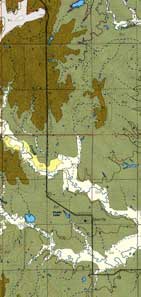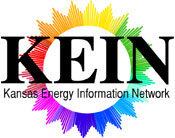Anderson County Geologic Map
A new geologic map of Anderson County, showing the age and type of rocks
at the earth’s surface, was recently released by the KGS. Because
geologic maps show the rock formations likely to be encountered at a particular
location, they are useful in construction, in understanding soils and
agriculture, in searching for water and mineral deposits, and in a variety
of engineering and environmental uses. The Anderson County geologic map,
compiled by retired U.S. Geological Survey geologist William D. Johnson,
Jr., is part of a Survey program to produce new geologic maps of counties
in the state.
The map, produced in full color, is drawn at a scale of 1:50,000 (one
inch on the map equals about 3/4 mile). Copies of the new map are available
from the KGS (contact pubsales@kgs.ku.edu).
The cost is $15.00 plus tax, shipping, and handling.
New Circulars on Coalbed Methane and the Public Land Survey System
Methane, the main component of natural gas, has been a product of the
petroleum industry for years. Now, a relatively new and unconventional
source of natural gas—methane from coal beds—has generated
interest in eastern Kansas. Natural
Gas from Coal in Eastern Kansas, by Robert Sawin and Larry Brady
(Public Information Circular 19), describes coal and coalbed methane,
gas production from coal, leasing and landowner mineral rights, and the
potential for coalbed methane production in Kansas.
The Public Land Survey
System in Kansas, Public Information Circular 20, by Daniel Suchy
explains how to use the system to legally describe a parcel of land using
township and range, section, and smaller divisions.
Copies of PIC 19 and 20 can be obtained free of charge by contacting
Publications Sales at the KGS. These circulars also are available electronically
through the Survey’s web site (www.kgs.ku.edu).
Current Research
Two new articles have been published in the Survey's online research bulletin,
Current Research in Earth Sciences. The first, Modeling
Dielectric-constant Values of Geologic Materials: An Aid to Ground-penetrating
Radar Data Collection and Interpretation, by Alex Martinez and Alan
P. Byrnes, was published in December 2001. It describes the use of dielectric-constants
(an electrical property of matter that influences radar returns) as a
tool in ground-penetrating radar (GPR) studies. GPR is a near-surface
geophysical imaging technique used for non-intrusive subsurface geologic
and engineering investigations. The second article, Response of Forest
to Climatic Events and Human Management at Fort Leavenworth, Kansas,
by James S. Aber, Juliet Wallace, and Matthew C. Nowak, discusses the
use of Landsat data to study the effects of climatic events and human
activities on forested areas in northeastern Kansas. The article was published
in January 2002.
These articles, along with previously published articles in the Current Research bulletin, can be viewed at www.kgs.ku.edu/Current/index.html.
New
Publications

Segment of Anderson County Geological Map.
Kansans
obtain their energy from a variety of sources. Most are conventional,
such as coal or natural gas, but some, such as wind, are new to Kansas.
Now, a comprehensive summary of energy information is available through
the Kansas Energy Information Network (KEIN).
Designed to be the first stop for those who seek energy information on
the internet, KEIN is provided as a service of the Kansas Corporation
Commission’s Energy Program and the University of Kansas Energy
Research Center, based at the Kansas Geological Survey.
In addition to information about traditional energy resources—coal,
natural gas, petroleum, and nuclear—KEIN provides information about
renewable and alternative resources such as solar, wind, hydropower, ethanol,
hydrogen, and fuel cells. The web site contains news articles, current
fuel prices, data, history, publications, and research reports, along
with information about conservation, environmental and safety issues,
agencies, producers, trade and nonprofit organizations, and educational
and industry resources.
For more information about the Kansas Energy Information Network contact Scott White at the Survey (785-864-2073, or whites@kgs.ku.edu).
Energy Information on the Internet

URL:http://www.kgs.ku.edu/Publications/GeoRecord/2002/vol8.1/Page3.html